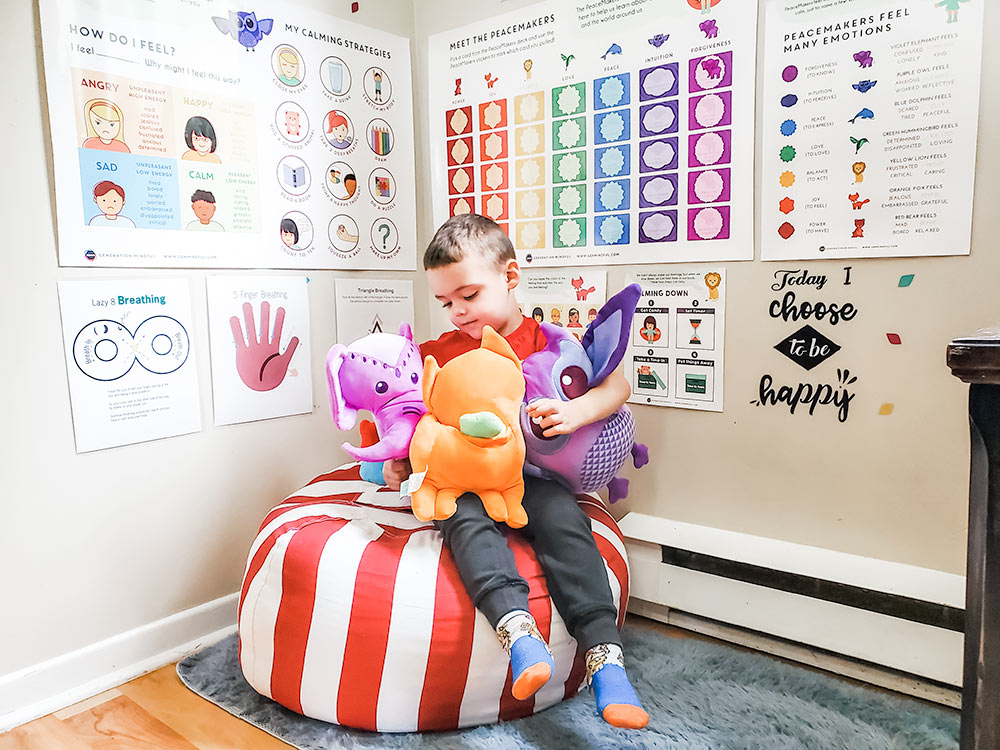13 Ways to Reduce Household Chaos & Create a Calmer Home
What’s inside this article: A review of current research on the effects of growing up in a chaotic household, along with actionable suggestions to help you reduce chaos, and add structure and consistency to your home.
Children are so loud, messy, and sometimes nuts. You’d think they thrive on the chaos. But, the opposite is true.
Children need structure and consistency, and in fact, too much chaos affects children’s physical and emotional development.
Research indicates that children growing up in chaotic households are more likely to have lower grades, less self-control, and poorer health. Contributing factors include excessive noise, lack of family routines, overcrowding, and general disorganization.
Some signs your home is too chaotic include:
- You find yourself getting overwhelmed by the amount of noise.
- There is a lot of clutter, and it’s challenging for your to keep the house tidy. Things never seem to be put back in their place,
- You are often running late for school, appointments, etc.
- Mornings, bedtimes, homework routines, household chores, etc., are exceptionally challenging.
- It feels like siblings are fighting or arguing every time you leave the room.
- You find yourself raising your voice or yelling more often than you want to.
The following suggestions can help make your home more harmonious.

Dealing with Excess Noise
Loud noises or excessive noises are overstimulating for many people, including parents.
It’s so hard for me to focus on something when there is TV on in the background, the muffled sound of my husband working downstairs, all three kids talking, singing, or making sound effects as they play, the dog barking, all on top of each other.
When this happens, I often feel like I can’t even have a single thought without being interrupted. This causes me to feel irritable and have less patience with my kids than usual.
And for the most part, the larger the family, the more noise. How do you reduce this noise?
Quiet Time
Set aside time for individual quiet activities like reading, drawing, coloring, or making crafts. If you have more than one child, separate them into different rooms during this time, so there aren’t loud conversations taking place.
Turn off the TV, music, or other background noise during quiet time as well. If your kids are independent enough not to require direct, undivided supervision, use this time to do your own quiet activity too.
Lower Your Volume
Do you find yourself raising your voice in an attempt to have the kids listen? Or, is everyone constantly interrupting one another?
Try to catch yourself when this happens and make an effort to speak more quietly.
For example, don’t yell to your children from the other room; go in and speak to them instead.
We taught the kids a silent way of letting others know you want a turn to speak. So instead of interrupting, place your hand on the person’s arm. They’ll then place their hand on top of yours, signaling they know you want to speak and will give you a chance in a moment.
Create a Calming Corner
A calming corner (or space, it doesn’t have to be a corner) is a comfortable and calming space for children to go when they need some space, to calm down their bodies, and to take a time-in to process their big feelings.
It is a positive and non-punitive alternative to time-outs that helps children develop emotional regulation, provides structure, and leaves them feeling safe and secure.
The goal when creating a calm down corner is to create a safe space in your home for your child to go if they’re upset or showing signs of anger or frustration. It’s not used to punish bad behavior, it’s a safe space for processing emotions.
As children become better at regulating emotions, and they feel like they have a safe place to go when they do have big feelings, they’ll have fewer outbursts, meltdowns, or tantrums.
Read: How to Create the Ultimate Calming Corner

Reduce Other Noises
If you can constantly hear traffic, emergency vehicles, construction, airplanes, persistently high volumes on the TV or music, the air conditioner running, etc., what you’re experiencing is noise pollution.
Prolonged exposure to noise pollution affects physical health, mental health, and children’s cognitive development.
Some soundproofing or minimizing tactics may be out of your control; we can’t all change the construction of our homes. But there are some things you can do to reduce sound in your home.
- Soft, dense materials, like heavy curtains, thick carpet, or rugs, will make the room they’re in quieter and less echo-y and slightly reduce the noise transmitted to other rooms.
- Seal cracks and gaps around windows and doors with caulking to reduce outside noise in your home.
- Thick padded carpets or rugs will also reduce the sound of footsteps and impact noises in the rooms below.
- Space refrigerators, dryers, and washing machines away from walls, so the walls don’t pick up and amplify the sound.
Suggestions for Creating Family Routines
Children need consistency to feel secure. Planning ahead also helps you save time and stay on track, reducing your stress levels.
Family routines are a great way to build consistency and predictability in your child’s life. Here are some routines you can begin incorporating into your day-to-day life.
Create a Consistent Bedtime Routine
Help your children develop healthy bedtime habits.
Try to keep everything about your bedtime routine as consistent as possible to help prepare your child for bedtime to form a consistent, predictable routine. You can find some tips here.
Try using a specific song or alarm to signify the beginning of your bedtime routine. From there, things should be done in the same order each night.
If your child doesn’t bathe or shower every night, do not include a bath in the bedtime routine. Instead, make bath time part of the mornings or after school.
Checklists are a helpful way to enforce new routines. Depending on your child’s age, you can create a bedtime routine checklist using visuals or text.
When I create daily checklists for my kids, I laminate the page, and then they use a dry erase marker to check off all of their tasks.
Eat together
Families are so busy these days; it’s often difficult for families to get everyone together around the table for a meal. However, if you can swing it, it’s a beneficial way to add consistency to the day.
There are several benefits to eating together as a family. It’s a time to share and connect, talk about the day, try new foods together, and form meal-time traditions.
If your schedules are too out of sync, planning a big Sunday meal together or themed meal nights, such as Taco Tuesday, is another way to create consistency around meals in your home.
Use a Visual Schedule
Visual schedules are helpful for almost everybody, and they are such an easy way to present information.
Some of the benefits include:
- They are easily be understood, even by children who can’t yet read or are nonverbal.
- It helps establish healthy, constructive habits – such as personal hygiene and completing chores and homework daily.
- Provides stability – uncertainty may cause significant stress for some kids.
- Encourages independence because your kids don’t need to come to you asking what to do constantly.
- The home is the easiest place to teach kids long-term habits, and a visual schedule can facilitate that.
You can find tips for creating and implementing your own visual schedule here. You can also find templates and graphics for your visual routine here.
Host Family Meetings
Host a family meeting once a week. Go over upcoming events, meal plans, appointments, etc., with the whole family.
Weekly meetings help children feel included in what’s taking place within the family, and it allows open communications and bonding. Allow everyone to provide input during these meetings.
Remember to add some fun items to the agenda, too, like eating ice cream or a trip to the park.
More Ideas
These are just a few more ideas to help you build a calm, structured household.
Review Your Parenting Style
Researchers have identified four distinct parenting styles; do you know your style?
Studies show that parents in chaotic households use harsher discipline and less supporting parenting strategies.
While there are many exceptions, it can never hurt to take a moment to evaluate your parenting style and if it’s impacting your child.
Teach Missing Social-Emotional Skills
Books, social stories, videos, and creative play help teach critical social-emotional skills that, over time, will cure the chaos.
Research shows that reading a book about something activates the same pathways in the brain as when we go through something ourselves.
There are children’s books covering any theme or challenge you can imagine, so if something, in particular, is adding stress at home, see what’s out there to teach skills to make it better.
Only focus on one or two things at a time, so it’s not overwhelming. If you’re struggling with routines, siblings arguing, hitting, chores, back-talking, etc., all at the same time – choose one to work on.
Julia Cook is a children’s author who writes impressive social-emotional learning books for kids. Her books teach kids strategies they can actually use. She’s published over 100 books, but here are my top ten.
Relax
I know, easier said than done. But model how to manage stress, not just “how to be calm,” but how to enjoy the calm.
You could try doing a short guided meditation each morning, take an evening stroll, or practice deep breathing exercises as a family, to show your kids how to be mindful.
You can also try other quiet activities like coloring, crotchet, or puzzles to introduce your children to some quiet hobbies they may enjoy.
Tidy up
Your physical environment can increase anxiety and add to the chaos.
Reduce clutter, and find storage and organization solutions that work for your family so you don’t have “stuff” just laying around, or stuffed in random baskets or bags around the house.
Tidy up together. Give each family member a job to do and work together to tidy up. A 10-minute clean-up as a team can take care of most messes. Small children can put away toys or wipe down railings, while older kids can do larger jobs like vacuuming or dishes.
By the way, it’s a lot more fun if you put some music on and do it together.
Set priorities.
I think there will always be a certain level of chaos when you have children, especially when you have a big family like I do. Our lives are busy; our kids are rambunctious and loud.
But if it’s chaotic and it’s getting to you to the point that you’ve read all the way through this article, it’s definitely time to make some changes that will improve your life.
Make a list of things that are causing stress, confusion, and chaos, and then pick one or two areas at a time where you want to become calmer.
Try to identify the challenges, and create solutions. Pay attention to what your family does well, what works and doesn’t work, and evaluate your progress (maybe at those family meetings?)
Remember, different things work for different family’s – there’s no magic fix for all. But, reducing household chaos can benefit all areas of your life, your children’s lives, and their development. So it’s worth finding solutions that work for you.

